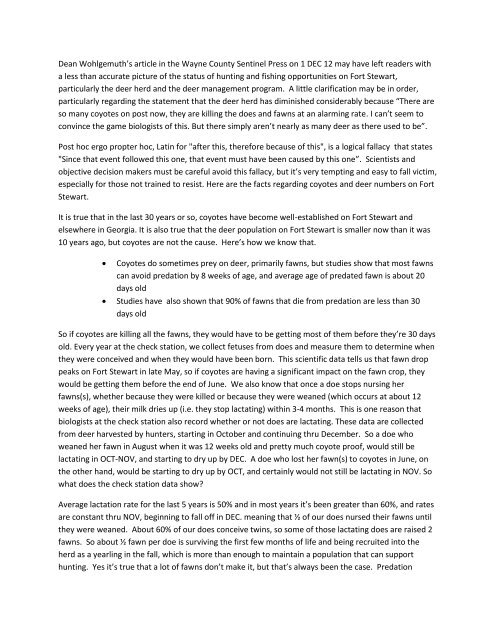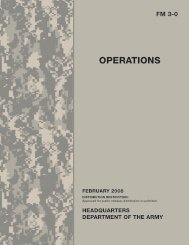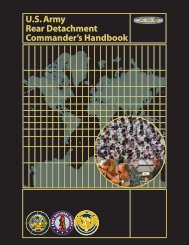Deer Article - Fort Stewart
Deer Article - Fort Stewart
Deer Article - Fort Stewart
You also want an ePaper? Increase the reach of your titles
YUMPU automatically turns print PDFs into web optimized ePapers that Google loves.
Dean Wohlgemuth’s article in the Wayne County Sentinel Press on 1 DEC 12 may have left readers with<br />
a less than accurate picture of the status of hunting and fishing opportunities on <strong>Fort</strong> <strong>Stewart</strong>,<br />
particularly the deer herd and the deer management program. A little clarification may be in order,<br />
particularly regarding the statement that the deer herd has diminished considerably because “There are<br />
so many coyotes on post now, they are killing the does and fawns at an alarming rate. I can’t seem to<br />
convince the game biologists of this. But there simply aren’t nearly as many deer as there used to be”.<br />
Post hoc ergo propter hoc, Latin for "after this, therefore because of this", is a logical fallacy that states<br />
"Since that event followed this one, that event must have been caused by this one”. Scientists and<br />
objective decision makers must be careful avoid this fallacy, but it’s very tempting and easy to fall victim,<br />
especially for those not trained to resist. Here are the facts regarding coyotes and deer numbers on <strong>Fort</strong><br />
<strong>Stewart</strong>.<br />
It is true that in the last 30 years or so, coyotes have become well-established on <strong>Fort</strong> <strong>Stewart</strong> and<br />
elsewhere in Georgia. It is also true that the deer population on <strong>Fort</strong> <strong>Stewart</strong> is smaller now than it was<br />
10 years ago, but coyotes are not the cause. Here’s how we know that.<br />
<br />
Coyotes do sometimes prey on deer, primarily fawns, but studies show that most fawns<br />
can avoid predation by 8 weeks of age, and average age of predated fawn is about 20<br />
days old<br />
Studies have also shown that 90% of fawns that die from predation are less than 30<br />
days old<br />
So if coyotes are killing all the fawns, they would have to be getting most of them before they’re 30 days<br />
old. Every year at the check station, we collect fetuses from does and measure them to determine when<br />
they were conceived and when they would have been born. This scientific data tells us that fawn drop<br />
peaks on <strong>Fort</strong> <strong>Stewart</strong> in late May, so if coyotes are having a significant impact on the fawn crop, they<br />
would be getting them before the end of June. We also know that once a doe stops nursing her<br />
fawns(s), whether because they were killed or because they were weaned (which occurs at about 12<br />
weeks of age), their milk dries up (i.e. they stop lactating) within 3-4 months. This is one reason that<br />
biologists at the check station also record whether or not does are lactating. These data are collected<br />
from deer harvested by hunters, starting in October and continuing thru December. So a doe who<br />
weaned her fawn in August when it was 12 weeks old and pretty much coyote proof, would still be<br />
lactating in OCT-NOV, and starting to dry up by DEC. A doe who lost her fawn(s) to coyotes in June, on<br />
the other hand, would be starting to dry up by OCT, and certainly would not still be lactating in NOV. So<br />
what does the check station data show?<br />
Average lactation rate for the last 5 years is 50% and in most years it’s been greater than 60%, and rates<br />
are constant thru NOV, beginning to fall off in DEC. meaning that ½ of our does nursed their fawns until<br />
they were weaned. About 60% of our does conceive twins, so some of those lactating does are raised 2<br />
fawns. So about ½ fawn per doe is surviving the first few months of life and being recruited into the<br />
herd as a yearling in the fall, which is more than enough to maintain a population that can support<br />
hunting. Yes it’s true that a lot of fawns don’t make it, but that’s always been the case. Predation
accounts for about half of all fawn mortality, but coyotes aren’t the only predators that take fawns. So<br />
while it’s true that coyotes may have an impact on fawn survival, it’s not enough of an impact to explain<br />
the observed decrease in deer numbers.<br />
So if coyotes aren’t decimating the deer population, why are there fewer deer? The answer is, in large<br />
part, because we made a conscious decision to reduce the QUANTITY of deer on <strong>Fort</strong> <strong>Stewart</strong> in order to<br />
improve the QUALITY of our deer. Much has been learned in the last 30 years about Quality <strong>Deer</strong><br />
Management (QDM) and what can be done to produce a greater number of trophy bucks. There is a<br />
limit to how many deer the habitat can support, which is called Carrying Capacity. QDM stresses the<br />
importance of keeping the deer population well below carrying capacity, and keeping the buck:doe<br />
ration as close as possible to 1:1. That means that there will be plenty of nutrition for all the deer, and<br />
about ½ of those deer will be bucks. If you start with a population of 100 deer with a 1:3 buck:doe ratio<br />
(25 bucks:75 does) and kill 50 does, you’ll only have half as many total deer, but you’ll still have just as<br />
many bucks as you started with, and there will be twice as much food available for them. That’s about<br />
where we were in 2003 when we increased the number of doe days from 10-15 per year to about 30 per<br />
year. We also established a Quality <strong>Deer</strong> Management Area (QDMA) in 2003 encompassing 8 Training<br />
Areas totaling about 15,000 acres, where all bucks harvested must have at least 4 points on one side. In<br />
2002, the state of Georgia implemented a similar regulation requiring that at least 1 of the 2 bucks each<br />
hunter is allowed to harvest each year must have at least 4 points on one side. Buck harvest on the<br />
remaining training areas was also restricted starting in 2002 when the state of Georgia changed the<br />
state-wide regulations to require that at least one of 2 deer harvest must have at least 4 points on one<br />
side. The result of reducing the total number of deer by harvesting more does and limiting the harvest<br />
of young bucks has been impressive in terms of herd quality. Among 1.5 year old bucks, average body<br />
weights are up about 9% overall, and main beam antler length is up about 15%, so improved nutrition is<br />
improving deer quality. As for trophy bucks, when we compare figures from 1984-2002 with data from<br />
2007-2011, the proportion of bucks harvested that were 3.5 years or older has increased by 50%. A<br />
picture’s worth a thousand words, as shown by the photos below from our annual camera surveys.
While the herd quality has been improving, the total number of deer harvested, based on<br />
harvest records turned in by sportsmen, has not changed significantly, but we do feel like we don’t need<br />
to reduce the herd further.<br />
5 YEAR AVERAGE HARVEST: 797, HIGH WAS 958 IN 2010 & LOW WAS 671 IN 2011<br />
10 YEAR AVERAGE HARVEST: 743, HIGH WAS 992 IN 2006 & LOW WAS 544 IN 2004<br />
<br />
LAST SEASON: 671 DEER REPORTED ON HARVEST CARDS<br />
DEER/MILE 2 : 35<br />
DOE:BUCK: 1.2:1<br />
Because we’ve reached our desired deer population level, we reduced the number of doe days back<br />
down to 17 days/year starting in the 2011-12 season.<br />
<br />
<br />
AVERAGE DOE HARVEST 2003-2011: 55% OF HARVEST<br />
2011-12 SEASON: DOE HARVEST WAS 49% OF DEER HARVEST<br />
Bottom line – The deer numbers are down and the herd quality is up, and coyotes aren’t responsible for<br />
either. It is indeed sometimes difficult to strike the proper balance, but results of our 2006 Sportsman<br />
Survey indicated that 77% of permit holders support or strongly support establishment of the QDMA,<br />
and 50% would support expanding the QDMA, so I think our balance is pretty good.
















